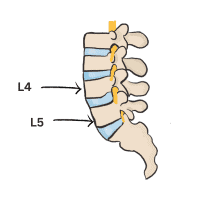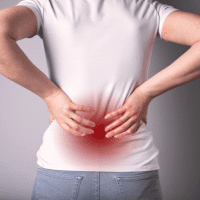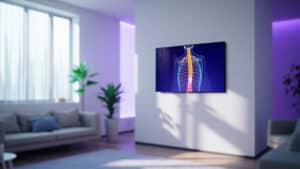Expert Insights into Managing L4-L5 Pain Symptoms
| Part | Function |
|---|---|
| Vertebrae | Supports the upper body and facilitates movement |
| Intervertebral Disc | Acts as a shock absorber between the vertebrae |
| Associated Nerves | Transmits signals between the brain and the body |
Introduction
Navigating the complexities of L4-L5 spinal pain requires not only medical expertise but also a pioneering spirit in embracing innovative treatments.
Dr. Matthias Wiederholz, a board-certified pain management doctor and a trailblazer in implementing the Discseel® Procedure in Houston, exemplifies a robust blend of expertise, authoritativeness, and trustworthiness in the realm of spinal health.
Trained personally by Dr. Kevin Pauza and recognized for his meticulous patient care, Dr. Wiederholz brings forth this comprehensive guide to understanding and managing L4-L5 pain symptoms, underpinned by his authoritative presence in the field.
L4-L5 Pain Symptoms
Back pain, especially in the lumbar region, is a common ailment that plagues many individuals worldwide.
The L4-L5 spinal segment, a crucial part of our lower back, often becomes a focal point for understanding and managing persistent pain symptoms.
As a board-certified pain management doctor, I’ve witnessed the profound impact that L4-L5 pain symptoms can have on daily activities and overall quality of life.
In this comprehensive guide, we’ll delve into the anatomy, symptoms, and management strategies related to L4-L5 pain, providing you with expert insights and actionable advice.
In-depth Exploration of L4-L5 Anatomy
Understanding the L4-L5 Spinal Segment
The L4-L5 spinal segment, comprising the fourth and fifth lumbar vertebrae and the disc in between, plays a pivotal role in supporting the upper body and facilitating movement.
This segment bears significant weight, making it susceptible to wear, tear, and associated pain.
Understanding its anatomy, including the vertebrae, intervertebral disc, and associated nerves, is fundamental in comprehending the origin of pain and formulating management strategies.

The Significance of L4-L5 in Spinal Health
The health of the L4-L5 segment is paramount in maintaining spinal stability and mobility. Issues in this region can lead to localized pain and radiating symptoms affecting the lower extremities.
Ensuring optimal health of this segment is crucial in preserving overall spinal integrity and mitigating potential pain symptoms.
Comprehensive Guide to L4-L5 Pain Symptoms
Chronic Lower Back Pain
Chronic lower back pain originating from the L4-L5 segment can manifest as persistent, dull aches to sharp, debilitating pains.
It may be exacerbated by activities like bending, lifting, or prolonged sitting, often indicating underlying issues such as disc degeneration or facet joint problems.
Understanding the nuances of this pain, its triggers, and patterns, is vital in formulating an effective management plan.

Leg Pain and Weakness
Sciatica, characterized by radiating leg pain, often stems from issues at the L4-L5 segment, such as a herniated disc impinging on the sciatic nerve.
This pain can vary in intensity and nature, sometimes accompanied by weakness, tingling, or numbness in the affected leg.
Recognizing the correlation between L4-L5 issues and sciatic symptoms can pave the way for targeted interventions.
Tingling and Numbness
Neurological symptoms like tingling and numbness, often resulting from nerve compression at the L4-L5 segment, can manifest in the lower back and extend to the legs and feet.
Identifying and addressing the root cause of these symptoms is crucial in preventing progression and managing associated discomfort effectively.
Real Stories and Case Studies
Patient Stories
Real people real stories, watch this video:
Expert Analyses: Introducing the Discseel® Procedure
Navigating through the myriad of treatment options for L4-L5 pain symptoms can be a daunting journey.
However, advancements in medical technology have paved the way for innovative, minimally invasive procedures that offer promising results for patients grappling with spinal pain.
One such cutting-edge solution is the Discseel® Procedure.

A Minimally Invasive Approach to Spinal Pain
The Discseel® Procedure emerges as a beacon of hope for those seeking a non-surgical approach to manage and potentially alleviate spinal pain.
Utilizing an FDA-approved Biologic Fibrin Sealant, this procedure is the only one proven to seal discs, encouraging them to heal and offering a novel approach to treating spinal pain.
The procedure is heralded for its ability to allow patients to relieve their low back and neck pain without resorting to surgery, presenting a viable option for those keen on exploring minimally invasive treatments.
The Discseel® Procedure: A Step-by-Step Insight
The Discseel® Procedure encompasses several key steps, each meticulously designed to ensure optimal outcomes for the patient:
- Consultation: Engaging in a detailed consultation allows the patient and physician to discuss the procedure in-depth, ensuring all queries are addressed and the patient is prepared for the procedure.
- Annulogram™: This test replaces traditional MRIs and Discograms, offering precise identification of disc tears and leaks, which is pivotal in tailoring the procedure to the patient’s unique needs.
- Treatment: The procedure involves the injection of Fibrin, an FDA-Approved biologic, to seal all disc tears, leveraging Fibrin’s natural healing abilities to facilitate recovery and manage pain.
- Recovery: The binding ability of Fibrin allows spinal discs to regain normal strength within a short timeframe, enabling patients to return to light activity swiftly, progressively increasing activity levels while Fibrin continues to facilitate healing throughout the year.
The Promise of Discseel®
The Discseel® Procedure not only stands out for its minimally invasive nature but also for its impressive success rates and long-term outcomes, which have been substantiated in peer-reviewed literature.
It offers a compelling alternative to traditional spinal surgery, providing patients with a procedure that is less invasive yet highly effective in managing spinal pain.
Aligning Expertise with Innovation
As a board-certified pain management doctor, integrating innovative procedures like Discseel® into treatment plans aligns with a commitment to providing patients with access to the latest, scientifically-backed interventions.
It is pivotal to continuously explore and integrate advancements in medical technology, ensuring patients are afforded the best possible care, particularly when navigating through persistent and debilitating pain symptoms such as those associated with L4-L5 spinal issues.
Incorporating the Discseel® Procedure into the management and treatment of L4-L5 pain symptoms presents a promising avenue, offering patients a scientifically-backed, minimally invasive solution to spinal pain.
It aligns with a commitment to providing comprehensive, innovative, and patient-centered care, ensuring individuals are afforded the best possible outcomes in their journey towards pain management and recovery.
Scientific Backing: Research and Studies
Latest Research on L4-L5 Pain Management
In the realm of spinal health, particularly concerning L4-L5 pain management, research and studies have paved the way for innovative interventions and strategies.
One such study, titled “Intradiscal Injection of Fibrin Sealant for the Treatment of Symptomatic Lumbar Internal Disc Disruption: Results of a Prospective Multicenter Pilot Study with 24-Month Follow-Up“, provides insightful findings related to the application of fibrin sealant in managing discogenic low back pain.
Objective and Design of the Study
The study aimed to assess the safety and efficacy of intradiscal fibrin sealant in adults grappling with chronic discogenic low back pain.
Conducted across three centers in the United States, this nonrandomized, FDA-approved pilot study engaged 15 adults, each experiencing chronic pain at a single or contiguous two-level lumbar discogenic pain, confirmed through meticulous provocation discography.
Intervention and Outcome Measures
The intervention involved the volume- and pressure-controlled intradiscal delivery of BIOSTAT BIOLOGX® Fibrin Sealant, utilizing the Biostat® Delivery Device into the symptomatic lumbar disc(s).
The outcomes were measured based on potential adverse events, assessed through neurological status, radiographic, and magnetic resonance imaging (MRI), and efficacy measures, which included serial assessments of low back pain visual analog scale (VAS) measurements and the Roland-Morris Disability Questionnaire (RMDQ).
Results and Conclusion
The results indicated no significant changes in safety neurological assessments, X-ray, and MRI. Adverse events were reported in nine subjects, with two instances of low back muscle spasm and one case of discitis considered related to the procedure or product.
Efficacy was demonstrated through a decrease in mean low back pain VAS scores and improvement in RMDQ score over 26, 52, and 104 weeks. The study concluded that intradiscal injection of BIOSTAT BIOLOGX Fibrin Sealant appears safe and may improve pain and function in selected patients with discogenic pain.
Incorporating the Discseel® Procedure
The aforementioned study illuminates the potential of fibrin sealants in managing lumbar disc disruption and pain, which aligns with the principles of the Discseel® Procedure.
Dr. Matthias Wiederholz, the first doctor to perform the Discseel® Procedure in Houston, and who was personally trained by Dr. Kevin Pauza, utilizes this innovative approach to offer a minimally invasive solution to patients experiencing L4-L5 pain symptoms.
The Discseel® Procedure, leveraging the natural healing abilities of an FDA-approved biologic fibrin sealant, presents a promising avenue for managing spinal pain, providing patients with a scientifically-backed, minimally invasive alternative to traditional spinal surgery.
In light of the findings from the study and the principles of the Discseel® Procedure, it becomes evident that the exploration and application of fibrin sealants in managing L4-L5 pain symptoms hold substantial promise.
This aligns with a commitment to providing comprehensive, innovative, and patient-centered care, ensuring individuals are afforded the best possible outcomes in their journey towards pain management and recovery.

Frequently Asked Questions (FAQs)
Q1: What Causes L4 and L5 Disc Problems?
A: L4 and L5 disc problems can arise due to various factors, including poor posture, lifting heavy objects, repetitive motions, and traumatic injuries, such as those from auto accidents. The spinal discs, which act as cushions between the vertebrae, can be subjected to excessive pressure or strain, leading to issues like lumbar disc herniation, especially as they become thinner and weaker with age.
Q2: How Does L4 and L5 Affect the Sciatic Nerve?
A: The L4 and L5 vertebrae impact the sciatic nerve, which encompasses the L4 nerve, L5 nerve, and several sacral nerves. Conditions affecting the L4 and L5 vertebrae can irritate the sciatic nerve, resulting in sciatica symptoms, which commonly include radiating lower back pain, numbness, and weakness.
Q3: What is L4-L5 Spinal Stenosis and How Does It Develop?
A: L4-L5 spinal stenosis is a condition where the spinal canal narrows, often resulting from age-related degeneration of the lumbar spine. This degeneration can lead to thickened spinal ligaments, herniated discs, and bone spurs from osteoarthritis, which, as the spinal canal narrows, can compress the nerves supplying the affected area.
Q4: Can L4 and L5 Damage Cause Hip and Buttock Pain?
A: Yes, damage to the L4 and L5 vertebrae can cause pain in the hips and buttocks, particularly when conditions irritate the sciatic nerve. The pain can travel from the lower back through the hips due to the nerve’s pathway. Additionally, osteoarthritis and lumbar strains and sprains in the L4-L5 region can also contribute to hip pain.
Q5: What is Spondylolisthesis at L4 and L5?
A: Spondylolisthesis at L4 and L5 involves a vertebra slipping out of position, impacting the vertebra below it. This condition often results from spinal instability, frequently due to age-related changes in spinal structures. The L4-L5 spinal level is notably susceptible to developing spondylolisthesis due to its flexibility and the impact it endures.
Conclusion: Expertise and Accessibility in Managing L4-L5 Pain Symptoms
Navigating through the complexities of L4-L5 pain symptoms necessitates not only a thorough understanding of the condition but also access to innovative and effective treatment modalities.
The Discseel® Procedure, with its scientifically-backed approach and minimally invasive nature, emerges as a beacon of hope for individuals grappling with persistent spinal pain.
Dr. Matthias Wiederholz: A Pioneer in the Discseel® Procedure
In the pursuit of providing comprehensive and advanced care, Dr. Matthias Wiederholz stands out as a pioneering figure in implementing the Discseel® Procedure.
As the first doctor to perform this innovative procedure in Houston and personally trained by Dr. Kevin Pauza, Dr. Wiederholz brings a wealth of expertise and a meticulous approach to managing spinal pain.
His commitment to integrating cutting-edge technology and procedures into pain management strategies ensures that patients are afforded access to the latest advancements in spinal care.
Accessibility to Expert Care
Dr. Wiederholz is available for consultations and procedures at both the Houston and Lawrenceville locations, ensuring that expert care in managing L4-L5 pain symptoms through the Discseel® Procedure is accessible to a wide array of patients.
His adept skills, coupled with a patient-centered approach, ensure that individuals receive tailored care, designed to address their unique needs and conditions effectively.
Navigating through the journey of managing and potentially alleviating L4-L5 pain symptoms is significantly enhanced by having access to experts like Dr. Wiederholz.
His expertise in the Discseel® Procedure, along with a commitment to providing patient-centered, innovative care, ensures that individuals are not only afforded the best possible outcomes but are also actively involved in a collaborative approach towards managing their spinal health.
Feel free to reach out to Performance Pain and Sports Medicine today and start you to a pain free life. Contact Us now.

















